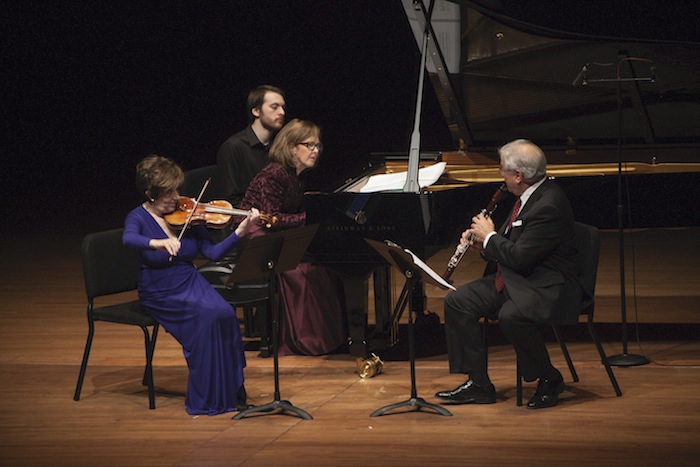CMS reflects enjoyably on Beethoven, Mendelssohn, and Jewish themes

Ida Kavafian, Anne-Marie McDermott and Davd Shifrin perform Paul Schoenfield’s Trio Sunday night at Lincoln Center. Photo: Lilian Finckel
It was best not to reflect too much on “Reflections,” the title the Chamber Music Society of Lincoln Center gave the program it performed Sunday afternoon in Alice Tully Hall.
While one was puzzling over the relationship between a sonata by the young Beethoven and a string quartet by the very young Mendelssohn inspired by the very old Beethoven, one could miss some fine performances.
And in the program’s second half, attractive works by Bloch, Prokofiev and Paul Schoenfield demonstrated how unrelated in style three pieces based on Jewish melodies could be.
No matter—it all made for an agreeably diverse afternoon of chamber music, beginning, as so many programs do, with an early violin-and-piano sonata by Beethoven, in this case Op. 12, No. 3 in E-flat major.
With the titanic sounds of the later Beethoven in our ears, it would be easy to think of a piece like this as a mere appetizer, instead of the ambitious, in-your-face statement it was in 1798. Violinist Ida Kavafian and pianist Anne-Marie McDermott avoided that trap, firing off the first movement’s sforzandos and sudden modulations with gusto (though shortchanging the audience a bit by omitting the exposition repeat).
Beethoven’s slow movements in this period included some of his broadest, deepest, most heart-on-sleeve utterances ever. They can be hard to hold together in performance, and on Sunday this sonata’s Adagio con molta espressione, while expressively played in its details, lacked the long line that can hold an audience spellbound.
In contrast, the Rondo finale lacked nothing in wit, rhythmic verve, and yes, even the long view to the spirited conclusion.
In his String Quartet No. 2 in A minor, Op. 13, one heard the 18-year-old Mendelssohn, aflame with the discovery of J.S. Bach and the late quartets of Beethoven, trying on those styles for size. Although we now know those clothes didn’t fit him very well, he was convincing enough in this work to inspire accolades from scholars and audiences ever since.
The quartet is framed at beginning and end by a vibrant Adagio in A major, in which the Calidore String Quartet—Jeffrey Myers and Ryan Meehan, violins, Jeremy Berry, viola, and Estelle Choi, cello—demonstrated its splendidly matched tone, sounding like a single instrument instead of four.
The mode shifted to minor for the first movement’s Allegro vivace and stayed there for most of the rest of the work, both signaling the seriousness of the young composer’s intentions and adding extra bite to his scintillating effects, deftly rendered by the group.
In the Adagio non lento, a sighing theme is interrupted by a disconsolate, chromatic fugue, which returns at the end for a tender reconciliation in the major key. The players caught all the swings of mood from Mendelssohnian lyricism to Beethoven-like wintry rumination.
The Intermezzo offered a high-stepping little tune with pizzicato accompaniment, again in minor, that put one in mind of Bizet or Tchaikovsky in their lighter moods.
Then, no doubt under Beethoven’s influence, the first violin stepped forward as protagonist of the finale, with an impassioned initial recitative and later a solo cadenza to usher in the coda. In between, the stormy Presto was as clear and bracing as the winter wind. A final blessing from the opening Adagio concluded the Calidore’s rich and convincing performance.
There is a difference between a recital piece and chamber music, and one was reminded of it by the rather deferential treatment given by violinist Kavafian and pianist McDermott to the “Nigun” movement of Ernest Bloch’s Baal Shem: Three Pictures of Hassidic Life.
Composed by Bloch for a virtuoso colleague’s recital, this boldly expressive, not to say flashy, piece seemed to call for a Heifetz, or at least some Heifetzian look-at-me attitude, rather than chamber-music collegiality. That said, the colleagues Kavafian and McDermott managed quite a forceful performance.
In contrast, Prokofiev’s Overture on Hebrew Themes for Clarinet, String Quartet, and Piano was chamber music through and through, composed for some of the composer’s old conservatory pals who had formed a band to play Jewish music.
Prokofiev, then in the midst of ambitious operatic and symphonic projects, was bemused by the success of this modest piece, in which a droll little dance and a more lyrical melody alternated until the composer declared “The End” in a comically abrupt coda.
Except for its Middle-Eastern-tinted tunes, this music was straight-up Prokofiev, no klezmer in sight, as it stepped along with ballet-like delicacy of pace and sentiment. The tone of David Shifrin’s clarinet, sounding the main theme in its lowest register, was pure chocolate cream.
Shifrin then proved his versatility, to put it mildly, by growling and screeching his way through Paul Schoenfield’s Trio for Clarinet, Violin, and Piano, one of that composer’s characteristic mash-ups of Brahmsian chamber-music style with klezmer exuberance.
In the furious first movement of this 1986 piece, Shifrin and Kavafian proved to be world-class note-benders. Alas, piano notes don’t bend, but pianist McDermott did execute some nifty blurring and sliding maneuvers, especially in the second movement’s march.
The third movement was the second Nigun of the afternoon—variously translated as “song” or “improvisation”—in which clarinet and violin intertwined over a very slow beat, two to a bar. After a brief surge of passion, the music became even more languid, almost motionless by the close.
McDermott’s brilliant, incisive playing drove the closing Kozatske (Cossack Dance) through abruptly shifting rhythms and moods. The three players toyed with the listener, halting the music when it seemed about to run ahead, but finally delivering the coda on an exciting crescendo.
Meanwhile, any remaining thoughts of how Beethoven and Mendelssohn were “reflected” in all this seemed to fly skyward with the clarinet’s wail.
The Chamber Music Society of Lincoln Center will present solo works of J.S. Bach, 5 p.m. Dec. 4, at Alice Tully Hall. chambermusicsociety.org; 212-875-5788.